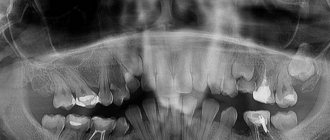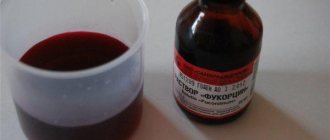Mechanisms of appearance
The appearance of redness in the oral cavity, namely on the palate, is provoked by several factors. Experts highlight the main ones of all existing ones.
Fungal
Oral candidiasis (thrush)
Among fungal infections, the leader is thrush , which develops against the background of disturbances in the gastrointestinal tract, namely changes in the microflora. The oral mucosa becomes covered with a rash - small but densely spaced red spots.
Provoking factors are: antibiotics, decreased protective functions of the body. In this option, antibacterial agents are prescribed to improve the functioning of the digestive system.
The characteristic red spots (in children there is a whitish coating) become brown during treatment, after which they completely disappear.
Bacterial
The presence of red spots in the mouth may indicate a bacterial infection, most often caused by streptococci. The development of bacteria is accompanied by changes in the soft tissue of the oral mucosa and skin. The lesions can be pinpoint or in the form of spots that merge with each other and form a single inflamed area.
Scarlet fever
The most common diseases of a bacterial nature are the following: tonsillitis, acute tonsillitis, scarlet fever, pharyngitis, etc. To eliminate the red rash, it is recommended to supplement drug treatment with topical antiseptic drugs.
Viral
One of the reasons for the formation of a red spot on the upper palate is a respiratory disease, which is characterized by the location of the infection in the oral cavity. In this case, not only the mucous membrane of the mouth is affected, but also the nose (rhinitis). A viral infection is recognized by the following signs:
- sore throat, dryness;
- discomfort when swallowing food;
- dry cough, worse in the morning or at night;
- muscle and headache.
Sometimes there is a sensation of a foreign body in the larynx. If the red spots do not have any plaque, then most likely the body has been infected by a simple virus. A whitish or other shade indicates the accumulation of pus. To make a diagnosis, you must make an appointment with a doctor.
The treatment process for a viral infection of the body does not require separate treatment of the rash; therapy is prescribed according to the standard regimen.
Allergic
Red spots on the palate can also be found due to allergies. Characteristic features:
- the location of the rash in the oral cavity is symmetrical;
- tiny dots (small pimples) in different places can merge, forming a larger spot;
- no burning, itching;
- red spots are also found on the skin;
- There are no other symptoms that worsen the person’s physical condition.
The first priority in dealing with stains is to identify the irritant and eliminate it.
Traumatic
Burns
This mechanism for the appearance of red spots on the mucous membrane is due to the influence of mechanical and physical factors. Mechanical impacts are those that irritate the soft tissues of the oral cavity over a long period of time or occur instantly.
In the first case, these may be dentures, sharp edges of teeth, or braces. The second option usually happens unexpectedly, for example, when the mucous membrane is bitten or damaged by a dental instrument. Physical effects include burns, electric shocks, and radiation exposure. Red spots are eliminated with special treatment, which is aimed at eliminating the consequences of injury, healing the wound and restoring the structure of the mucosa.
Vascular pathology
Spots or dots of red color due to pathological processes occurring in the vessels appear and disappear spontaneously and repeatedly .
In this case, only a comprehensive examination will help diagnose the problem.
A rash in the mouth may indicate the presence of coronavirus in a patient
Mucocutaneous lesions occur on average 12 days after the onset of other symptoms of the disease. Previously it was reported that infection with coronavirus can manifest itself in the form of a rash on the skin and even lead to the appearance of ulcers inside the mouth, the authors of this study for the first time stated that one of the symptoms of the virus may be enanthema - a rash on the mucous membrane.
Enanthema manifests itself as multiple small spots on the mucous membrane. The authors suggested that dentists can regard this sign as one of the symptoms of coronavirus and protect themselves if they inspect the mucous membranes for the presence of a rash before starting treatment.
“The presence of enanthema on the mucous membrane most likely indicates the viral nature of the rash,” says the author of the study, MD. Juan Jiménez-Coch, representing the Department of Dermatology at the Ramon y Cajal University Hospital in Madrid.
At the moment, researchers continue to work on finding drugs to fight the virus and developing a vaccine. At the same time, the list of symptoms of the disease is expanding, among which the most common are: headache, fever, sore throat. Less common symptoms include diarrhea, loss of smell and taste, vasculitis, and a rash similar to chickenpox. Enanthema will probably soon be added to this list.
At the university hospital, among patients with confirmed coronavirus, 21 patients were identified who also had manifestations of a rash. Among this group, enanthema variants were found in 6 patients. The age of patients from the study group was from 40 to 69 years, among them there were 4 women and 2 men.
Different types of enanthems
One patient had a macular type of enanthema, two had a petechial type, and three had both types of enanthema. The rash was localized to the palate.
In patients with petechial enanthema, the rash appeared faster than in patients with the macular type of rash. Laboratory tests of the patients did not reveal any abnormalities that could explain the appearance of the rash by another cause. The use of medications by patients also could not be associated with the appearance of enanthema. It is known that such rashes often occur under the influence of a viral load, although sometimes they can act as an adverse reaction to taking medications.
A reliable characteristic of the viral origin of the rash is its localization in the oral cavity. Vesicular and petechial types of rash are associated with the entry of the virus into the body, and the petechial type of enanthema is more common in adult patients.
In this study, 83% of patients had a petechial type of enanthema, or a predominantly petechial type. It is noteworthy that in two patients the rash appeared either 2 days before the onset of the main symptoms of coronavirus, or 2 days after the onset of these symptoms. In this regard, the authors made a convincing assumption that the rash in these patients could not appear as a reaction to taking medications.
The study authors report that the validity of the results may have been affected by the small number of participants and the lack of a control group of patients. “Although doctors are increasingly reporting cases of rashes in patients with confirmed coronavirus, it remains difficult to determine what the true causes of skin rashes are,” the authors say.
If there are red spots on the sky - this is stomatitis
With stomatitis, the spots that appear on the palate are located separately from each other or merge to form islands. Their color can range from pale pink to bright red.
Experts distinguish several types of the disease:
- viral;
- herpetic;
- candida;
- aphthous;
- bacterial;
- traumatic.
In addition to redness, the disease is characterized by the following symptoms:
- swelling of soft tissues;
- nervousness due to pain in the mouth;
- refusal to eat;
- in some cases, an increase in temperature.
Drug treatment involves the use of topical and oral drugs:
- Famciclovir – taken orally, daily dose – 1500 mg;
- Valacyclovir - take the drug 2 times a day, 2000 mg;
- Miramistin - used for rinsing the mouth 4 times a day, the duration of one treatment is at least 1 minute;
- Amiksin is a means to strengthen the immune system, prevents relapses, and is taken according to the schedule.
To enhance the effect of drug treatment, it is allowed to use rinsing compositions prepared according to traditional recipes:
- decoctions based on chamomile, calendula and other plants that have antiseptic and anti-inflammatory effects;
- carrot juice diluted half with warm water;
- horseradish root juice mixed with an equal amount of water;
- white cabbage juice, diluted with a small amount of water;
- linden infusion (200 ml), mixed with soda (1/2 tsp).
If it's a sore throat
The source of the disease is a virus, transmitted by airborne droplets. The spots in the mouth grow instantly, forming one continuous redness.
Symptoms:
- abdominal pain;
- a sharp increase in temperature, maintaining high levels for several days;
- redness of the oral mucosa;
- copious amounts of saliva;
- increase in lymph node parameters;
- muscle weakness;
- pain when swallowing;
- red spots on the palate turn into bubbles with cloudy liquid;
- Erosion remains at the site of the opening of the blisters.
The patient is prescribed 4-6 times of gargling with antiseptics, anti-inflammatory drugs, antipyretics and painkillers. Children under one year old, as well as patients with complications, are sent to the hospital.
During the treatment period, it is necessary to exclude aggressive foods and foods with a hard structure from the diet, so as not to provoke injury to the inflamed mucosa.
Traditional therapy can be supplemented with folk remedies:
- drinking teas based on rosehip, lemon, raspberry;
- gargling with decoctions (sage, chamomile, linden, onion peel);
- resorption of honey;
- rinsing the mouth with beet juice, saline solution, garlic infusion.
“Measles in adults: how dangerous is the disease and how to avoid it?”
28.01.2020 00:00
Measles is an acute viral disease that is one of the most contagious and common infections. Although we are accustomed to thinking of measles as a common childhood disease, it is very dangerous. Every hour in the world, 15 people die from measles, which amounts to 165,000 people a year. Is it possible to avoid a dangerous infection?
How can an adult get measles?
Measles infection occurs through airborne droplets. The contagiousness index is 95%, which means that this disease is highly contagious. To transmit the infection, direct contact with the patient is necessary; transmission of the virus through common things and third parties is impossible.
Today, measles is actively spreading among the adult population.
Cases of the disease are recorded all year round, but more often during the cold season. Children aged 4 and 5 years are most often affected. Babies under one year old who have received antibodies against the virus from their mother are immune in the first 4 months of life. In the future, the immune system weakens and the child (through contact with a sick person) may become infected. The patient remains contagious until the fifth day from the appearance of the rash, and in case of complications - until the tenth day.
Doctors say that the only bright spot in all this is a very powerful lifelong immunity after an illness.
Symptoms of measles in adults
When measles occurs in adults, the main symptoms remain the same as in children, but the severity of the disease in an adult will be more pronounced. The main symptoms of measles in adults are:
- increase in temperature (fever) up to 38 - 40 ° C;
- headaches, weakness;
- decreased appetite;
- conjunctivitis, rhinitis, photophobia;
- dry, hacking cough;
- hoarseness of voice;
- measles enanthema - large red spots on the soft and hard palate;
- rash on the skin (on the face, torso, arms, legs);
- possible delirium, impaired consciousness;
- intestinal dysfunction, etc.
The incubation period for measles infection lasts 1-3 weeks in adults. In the typical course of the disease, three successive stages can be distinguished: catarrhal, rash and convalescence stages.
In adults, measles is especially severe. Pneumonia and bacterial complications are often associated with the underlying disease. Sometimes the disease can result in blindness and significant hearing loss. One of the most dangerous complications of measles is viral meningoencephalitis (inflammation of the meninges), leading to death in 40% of cases. The measles virus greatly suppresses the immune system of an adult, as a result of which chronic diseases worsen and new ones are acquired.
Measles vaccinations in adults
If vaccinations were previously carried out:
The only possible method to prevent measles in adults is vaccination. Measles vaccination is usually given to children in several stages, providing protection against the virus. But over time, its effectiveness weakens. It is believed that measles vaccination can provide reliable immunity for nine to twelve years or more. Therefore, to maintain protection against viruses, revaccination may be carried out in adulthood. For it, so-called mono-vaccines are used, containing only the measles component. If desired, it is possible to use combination products that also contain weakened rubella and mumps viruses. In order to find out whether an adult’s body can resist measles (whether there is immunity from this disease), it is necessary to take a special blood test that will show the level of immunity tension. This test allows you to detect the presence of antibodies to the measles virus and is carried out within one to several days.
If vaccinations have not been carried out
Adults who have not been vaccinated before, have not had measles, or do not know about their vaccination will also benefit from taking tests to determine their antibody levels. It is quite possible that their measles occurred in a latent form, and they do not need vaccinations. But if it is not possible to carry out such a study, doctors recommend vaccination. Vaccination of unvaccinated adults is carried out with a single vaccine at an interval of three months. If a person was previously vaccinated once, then vaccination is carried out again - twice.
If you have been in contact with someone with measles
Adults who have been in contact with people with measles may be given measles immunoglobulin to prevent infection. This medicine contains synthesized human blood proteins containing antibodies to measles. Its administration promotes the formation of passive immunity and helps reduce the likelihood of measles infection. The use of measles immunoglobulin makes it possible to achieve passive disease prevention for two months.
Doctors warn that adults who have not had measles and have not received vaccinations should pay special attention to the symptoms that begin the development of the disease (and the first symptoms are very similar to a common cold) and never delay contacting a doctor and begin appropriate treatment .
If it's tonsillitis
The disease occurs in an acute form, affects the palatine tonsils, and the causative agent is streptococcus. During the development of the disease, a large number of toxins and antigens are released, which destabilizes the functioning of the joints, heart muscle, and kidneys.
Characteristic symptoms:
- pain in the larynx, radiating to the neck and ears;
- increase in body temperature (slight);
- headache, brittle bones;
- tonsils become covered with plaque, the surface becomes loose;
- lymph nodes enlarge.
For drug treatment, antibiotics of the penicillin group (Augmentin, Amoxiclav) or macrolides (Sumamed, Azithromycin) are recommended. Local agents are also prescribed (Lugol's solution, antiseptics, antibacterial spray).
To increase the effectiveness of treatment, namely to eliminate red spots, traditional medicine recipes are also used:
- gargling solution made from warm water (200 ml), soda (tsp), salt (tsp), iodine (5 drops);
- decoctions and infusions of plants (calendula, raspberry leaves, peppermint, oak bark, wormwood, plantain leaves, etc.);
- teas from black currant, honey, linden blossom, rose hips, marshmallow, etc.;
- chewing propolis;
- warm compresses on the neck.
What other diseases can cause the appearance of red spots on the palate in children and adults?
If red spots appear on the palate of yourself or your child, be sure to consult a doctor.
A person can encounter the problem of redness of the palate only once during his life or periodically, which is due to the nature of the disease that has these symptoms. Relapses include herpes, thrush, and enterovirus infections.
Once the body has been affected, it is impossible to get rid of them. When conditions are favorable for viruses and bacteria, the disease worsens, so it is important to take preventive measures to suppress the pathogen.
The characteristic red rash in the mouth is one of the symptoms of other diseases.
- of tuberculosis is flat red spots on the oral mucosa. Over time, the reddish or red-yellow inclusions merge to form plaques. The surface of the formations is heterogeneous, the color becomes red-bloody.
- ARVI is recognized in particular by red spots on the soft palate and tongue. Associated symptoms are characteristic of acute respiratory diseases.
- Oncology, among a large number of signs, has one more, which is related to the oral mucosa. A small ulcer forms on the palate, increasing in size over time. However, at first it does not cause discomfort, there are no painful sensations. Reaching large volumes, the ulcer begins to interfere, and difficulty is experienced when swallowing.
- Vitamin deficiency is characterized by a deficiency of vitamins and minerals important for all body systems. Their deficiency weakens protective functions and increases vulnerability to bacteria, fungi, viruses and infections. Red spots with vitamin deficiency are located locally on the skin and mucous membranes, without spreading intensively to neighboring areas.
- Herpes is a viral infection that once it enters the body, does not disappear. The disease worsens against the background of weakened immunity. A characteristic sign: small red spots on the mucous membrane, increasing in size, transforming into small bubbles with liquid inside.
- Chickenpox is diagnosed mainly in children under 14 years of age, but this does not exclude the risk of infection in adults. Not only the skin, but also the mucous membranes are covered with spots. In the mouth you can first find small red dots, which turn into bubbles and very soon burst. This results in gray or yellow ulcers with redness around the circumference.
- Measles is characterized by a rash on the skin and mucous membranes, high fever, general physical weakness, and lack of appetite. The affected area even extends to the mucous membrane of the eyes. Initially, white spots form in the mouth behind the cheeks, and as it moves to other areas, the rash acquires a bright red tint.
- Infectious mononucleosis is recognized by its extensive affected area; spots cover not only the palate, but the entire oral mucosa. There is a soreness in the larynx, and the tonsils increase in size. Breathing becomes difficult due to nasal congestion. Characteristics of the spots: the color is bright, the parameters are impressive, they appear more often along the palate, and quickly spread to other areas.
- Scarlet fever is recognized by red spots that are localized on the soft palate. Other signs of the disease: headache, fever, nausea, pain when swallowing. The tongue becomes crimson in color, the mucous membrane is inflamed, and the rash on the skin is very itchy.
A similar mechanism for the appearance of spots in each individual case still has characteristic features and accompanying signs by which the diagnosis is made. But sometimes even the experience and colossal knowledge of a specialist do not make it possible to diagnose the problem without laboratory tests. Therefore, you should not postpone going to the clinic so that the situation does not get out of control.
Skin rashes in children: rashes, exanthemas, enanthemas
Rashes on the skin (exanthema, exanthema ) and mucous membranes (enanthema, enanthema ) can occur not only with viral and bacterial infections, but also with diseases of a non-infectious nature.
It is important to decide whether these changes represent a primary injury to the child's skin or whether the clinical signs have changed due to secondary factors (infection, trauma, or treatment). Examination by a pediatric dermatologist Moscow - Markushka clinic.
Elements of rashes in a child, children. Primary and secondary elements
There are primary and secondary elements of rashes. Primary elements are classified as roseola, spot, papule, nodule, wheal, vesicle, vesicle, hemorrhage. Secondary elements include pigmentation and depigmentation, scale, crust, erosion, crack, abrasion, ulcer, scar, cicatricial atrophy, lichenification, vegetation.
Primary elements of rashes in a child, children: roseola, spot, erythema, hemorrhage, pinpoint hemorrhages - petechiae, papule, tubercle, node, blister, vesicle, bubble
Roseola is a pale pink or red speck ranging in size from 1 to 5 mm. The shape is round or irregular, the edges are clear or blurred, does not protrude above the skin level, disappears when the skin is pressed and stretched. Roseola occurs in many infectious diseases, especially typhoid fever. Multiple roseola 1-2 mm in size are usually described as a pinpoint rash (with scarlet fever), in the process of resolution they become covered with scales or disappear without a trace.
The spot (makula) has the same color as roseola, size - from 5 to 20 mm, does not protrude above the skin level. The shape is most often incorrect. The spot disappears when pressure is applied to the skin and appears again after the pressure is removed. Multiple spots ranging in size from 5 to 10 mm are described as a small-spotted rash (for example, with rubella - a child is vaccinated against rubella at the Markushka children's clinic). Spots 10-20 mm in size form a large-spotted rash (for example, with measles, allergies - examined by a pediatric allergist in Moscow, Markushka clinic).
Erythema is large areas of hyperemic skin that are red, purple-red, or purple in color. It occurs as a result of the fusion of large spots formed by the dilation of blood vessels not only of the papillary layer of the skin, but also of the subpapillary vascular plexus. Spots larger than 20 mm that tend to coalesce should be considered erythema. Erythema is most typical for erysipelas, thermal, and ultraviolet burns .
Hemorrhage (haemorrhagia) is bleeding into the skin as a result of destruction of skin vessels. It looks like dots or spots of various sizes and shapes and does not disappear when the skin is stretched. The color is initially red, purple or violet, then, as the hemorrhage resolves, it becomes yellow-green and finally yellow (formation of hemosiderin during the breakdown of red blood cells). Color changes are clearly visible in larger hemorrhages.
Pinpoint hemorrhages are called petechiae (petechia). Multiple round hemorrhages measuring 2 to 5 mm are described as purpura . Irregular hemorrhages measuring more than 5 mm are called ecchymoses . Hemorrhages may overlap with other elements of the rash. In such cases, they speak of petechial transformation of roseolas, spots, papules. As a rule, this is observed in severe cases of the disease. Hemorrhagic rashes are detected with typhus (often in combination with roseola - roseola-petechial rash), hemorrhagic fevers, and sepsis. Hemorrhagic elements of irregular shape on a dense basis (stellate rash) are characteristic of meningococcemia and pneumococcal sepsis. Minor hemorrhages can also have a non-infectious origin (capillary toxicosis, toxic-allergic vasculitis, vitamin deficiency C, etc.).
Papule (papula) is an element of the rash that rises above the level of the skin, which is often determined by touch. It has a flat or dome-shaped surface, size - from 1 to 20 mm. The shape and color are the same as those of roseolas and spots. Papules often leave behind pigmentation and flaking of the skin. Papules that merge with each other form plaques, and when the latter merge, areas appear that are located on large areas of the skin, the size of a palm or more. Often, during a routine clinical examination of a child, it is very difficult or even completely impossible to distinguish roseola from papules. On the other hand, the same sick child can simultaneously have roseola, papules (typhoid fever, paratyphoid fever, infectious mononucleosis), papules and spots (measles - child measles vaccination, children's medical).
A tubercle (tuberkulum) is a limited, dense, cavityless formation protruding above the surface of the skin with a diameter of 1-2 to 5-10 mm. The tubercles are formed as a result of the accumulation of a specific inflammatory infiltrate in the dermis. Clinically, the tubercle is similar to a papule, but differs from it in that when palpating the tubercle, a dense infiltrate in the skin is always clearly visible. In addition, tubercles, unlike papules, undergo necrosis during reverse development, often form ulcers and leave behind a scar or cicatricial atrophy of the skin. The tubercles are most typical of cutaneous leishmaniasis, leprosy and tuberculous skin lesions, tertiary and late congenital syphilis.
A node (nodus) is a cavityless, limited compaction that goes deep into the skin, often standing above the skin level. The size of the knots ranges from a hazelnut to a chicken egg and more. They are formed as a result of the accumulation of cellular infiltrate in the subcutaneous tissue and the dermis itself. Inflammatory nodules have a soft or doughy consistency, unclear boundaries, and the skin over them is red. Nodules that appear as a result of specific inflammation (colliquatic tuberculosis, syphilitic gumma) have a dense consistency, are sharply demarcated from the surrounding tissues, and are prone to decay and ulceration with subsequent scarring.
A blister (urtica) is an acutely inflammatory, cavity-free element slightly elevated above the skin level, measuring from 2-3 to 10-15 cm or more, has a round or oval shape, and is often accompanied by itching. Color - from white to pale pink or light red. The blister usually forms quickly and disappears quickly, leaving no trace behind. It occurs as a result of limited acute inflammatory swelling of the papillary layer of the skin and simultaneous expansion of the capillaries. The appearance of urticarial elements is characteristic of allergic reactions of various origins (drug, food, cold allergies), including those of an infectious nature. Sometimes occurs in the pre-icteric period of hepatitis B (vaccination of a child against hepatitis in the Markushka children's clinic).
A vesicle (vesicula) is a cavity element measuring from 1 to 5 mm, representing a detachment of the epidermis. Usually the bubbles are filled with transparent, cloudy or bloody contents, they can shrink and give a transparent or brown crust. If the cover of the bubble is opened, then erosion is formed - a wet surface of pink or red color limited by the size of the bubble. The bubbles do not leave any scars on the skin. If a large number of leukocytes accumulate in a vesicle, it turns into an abscess - a pustule. Inflammatory changes are noted at the base and around the vesicle. Pustules are divided into single-chamber (chickenpox) and multi-chamber (natural smallpox). A group of blisters located on inflamed skin is called herpes. Vesicles are characteristic of herpes and enterovirus infections, chickenpox and natural pox. Chickenpox vaccination - Markushka Children's Clinic.
Bubble (bulla) is a cavity element with a diameter of up to 3-5 cm, located in the upper layers of the epidermis and under the epidermis. The contents of the blisters can be serous, bloody, or purulent. They can collapse, forming a crust, or open up, forming an erosive surface that turns into unstable pigmentation. The bubble occurs more often against the background of an erythematous spot, less often - against the background of unchanged skin (neonatal pemphigoid). The elements can be located both inside the epidermis, in the styloid layer (pemphigus vulgaris), and under the epidermis (multiform exudative erythema, dermatosis herpetiformis). It is observed with bullous form of erysipelas, sometimes with chicken pox, thermal burns.
Secondary elements of rashes in a child, children: hyperpigmentation, depigmentation, scales, erosion, abrasion, ulcer, cracks, tears, crust, scar, lichenification, vegetation
Secondary morphological elements are formed as a result of the evolution of the primary elements of the rash .
Hyperpigmentation (hyperpigmentatio) is a change in skin color as a result of an increase in melanin in it or the deposition of hemosiderin of primary elements.
Depigmentation (depigmentatio) occurs as a result of a decrease in the melanin content in the skin, observed after the disappearance of a nodule, tubercle - resolution of spotty-flaky (pityriasis versicolor, eczematoids) and papular (psoriasis) elements.
Scale (sguama) is an accumulation of rejected cells of the stratum corneum, sometimes the underlying layers of the epidermis. Scales occur on primary morphological elements - papules (psoriasis, syphilis), tubercles, after the resolution of blisters (eczema), etc.
Erosion (erosio) is a skin defect within the epidermis as a result of the opening of a vesicle, blister, or abscess, repeating their shape and size. When vesicles and pustules merge, erosions have scalloped edges. Erosion can also occur as a result of maceration of the skin in the area of folds or during maceration of other elements of the rash, most often papules. When erosion heals, there is no scar left; usually there is only temporary pigmentation.
An abrasion (excoriatio) is a violation of the integrity of the skin that occurs as a result of scratching, scratching, or other damage. Abrasions can be superficial - within the epidermis, sometimes involving the papillary dermis, and heal without a scar. Deeper abrasions, involving the deeper layers of the dermis, leave behind a scar. Abrasions are characterized by a tendency to become infected.
An ulcer (ulcus) is a deep skin defect that reaches the dermis, subcutaneous fat, fascia, muscles, and bones. It occurs as a result of the breakdown of the tissue of the primary element (tubercle, node, ecthyma). Its size is from 1 mm to the size of a coin or palm and more; the shape can be round, oval, linear, oblong, irregular. The surrounding tissue is either inflamed (edema, hyperemia) or infiltrated. Ulcers always heal with the formation of scars.
Cracks, tears (fissura, rhagades) - linear damage to the skin in the form of its rupture, resulting from excessive dryness due to loss of elasticity due to inflammatory infiltration or overstretching of the skin. Cracks can be located within the epidermis and dermis. They are usually localized in the corners of the mouth, interdigital folds, on the palms, soles, above the joints, and in the anus. A superficial crack after healing leaves no traces. After healing of deep cracks, linear scars remain.
A crust (crusla) is formed on the skin as a result of drying of the discharge of a weeping surface (vesicle, vesicle, abscess, ulcer, erosion). The crusts can have different colors (with serous exudate, transparent with a yellowish tint; with purulent exudate, yellow, greenish or brown; with hemorrhagic exudate, brown or black) and shape (layered, oyster-like, etc.).
A scar (cicatrix) is the formation of connective tissue at the site of a deep defect. Occurs after healing of deep skin defects at the site of ulcerated tubercles, deep pustules, nodes, deep burns, wounds. Scar formation is accompanied by the death of sebaceous and sweat glands, hair follicles, blood vessels and elastic fibers, and the disappearance of the skin pattern. Typically, scars are located below the skin level or are at its level, less often they rise above the skin level - hypertrophic scars.
Lichenification (lichenificatio) is a focus of increased skin pattern, accompanied by thickening and compaction, hyperpigmentation, and dryness. Foci of lichenification are most often localized in the neck, elbow and popliteal folds, wrist and ankle joints, inguinal folds, scrotum and occur in chronic dermatoses accompanied by itching (eczema, neurodermatitis).
Vegetation (vegetatio) is a papillary thickening of the skin that occurs as a result of the growth of the styloid layer of the epidermis and papillomatosis of the dermis during a long-term inflammatory process. More often it forms in the area of papular elements and ulcers. Vegetations can erode, bleed, and are prone to secondary infection.
Allergic spots
If the cause is an allergy, the doctor will prescribe antihistamines.
Red spots on the palate, which are not accompanied by symptoms of intoxication and a sharp drop in body temperature, may indicate an allergic reaction of the body. Among the main irritants that provoke changes in the color of the tissues of the oral mucosa are the following:
- taking medications;
- installation of a filling made of composite materials or a crown made of polymers;
- products;
- dental pins, prosthetic structures;
- products used for oral hygiene.
You should also not exclude typical allergens: animal hair, flowering plants, detergents based on chemical compounds used for household needs.
You can neutralize the effect of irritants with the help of antihistamines. They are selected individually, taking into account the type of allergen and the state of the immune system. Pharmacological agents that have an antihistamine effect are systemic and local. The success of treatment depends on the speed of elimination of the pathogen.
Red spots in the mouth during poisoning appear as a result of capillary paresis. The classic variant is a meningitis rash. It is recognized by the following sign: when pressed, the spots turn sharply pale, the color gains intensity as the impact weakens.
Rare diseases
Sometimes, behind red spots in the oral cavity lies the symptoms of rare, but quite dangerous diseases. The success of their treatment directly depends on early diagnosis and timely drug treatment, which minimizes the development of serious complications.
| Rare diseases | |
| Name | Description |
| Pyogenic granuloma | Dome-shaped erythematous nodular fragments form on the oral mucosa. Red spots often open and bleed, the process is accompanied by burning and pain. |
| Petechiae | An erythematous rash appears in the oral cavity, which occurs against the background of infectious mononucleosis. |
| Kaposi's sarcoma | It is characterized by the appearance of a non-inflammatory rash on the oral mucosa, provoked by the development of oncology. Later, the affected area spreads to the skin and lymph nodes. |
Often, red spots on the roof of the mouth signal simple problems; rare diseases are diagnosed in only 5% of cases. However, this is not a reason to postpone going to the clinic, because the insidiousness of such diseases lies in the intensive progression and development of complications, ending in suffocation against the background of swelling of the larynx.
Diagnostics
The success of any treatment process directly depends on the accuracy of diagnosing the problem. If you notice red spots on the roof of your mouth, you should consult a physician. You will also need to undergo an examination by a dentist and otolaryngologist. If there is a suspicion of an infectious disease, the specialist will refer you for a scraping to identify the pathogen.
Drug treatment involves taking antibiotics and antiviral drugs. Among other things, local treatment of the throat and oral mucosa is prescribed through regular rinsing procedures. Regardless of the disease, it would be appropriate to use a vitamin complex to strengthen the body’s protective properties.
The main aids in making a diagnosis are laboratory tests of blood and urine. Characteristic symptoms and test results indicate a particular problem.
Why does my child have red dots on his throat?
A child may experience redness in the throat due to various diseases, but all these diseases can be combined into three groups:
- viruses
- bacteria
- allergy
Each individual disease and group of diseases have certain signs by which you can navigate, which is why protrusions appeared on the mucous membrane. But an accurate diagnosis can only be made by a specialist with proper diagnosis.
Viruses
A viral infection is often accompanied by spots on the throat. Most often, these spots are red and small, they appear on the upper palate, back wall and uvula.
In addition to spots on the throat, viruses have several other symptoms:
- high body temperature;
- the child feels weak;
- a runny nose appears, and the child also begins to sneeze frequently;
- a dry cough appears.
In cases of a viral infection, separate treatment for red spots on the throat is not required. It is enough to treat the disease with standard methods: gargling, taking cough suppressants, staying at rest, and regularly drinking fluids.
With influenza, the enanthema will have a bright red appearance, with granular rashes. These spots in the throat appear approximately on the second day of illness, along with other symptoms of the disease: chills, body pain, weakness.
Influenza is treated in the same way as viral infections, but with the caveat that this disease is more complex and develops faster, so powerful drugs (Tamiflu, etc.) are used in treatment.
Other viral infections that can cause enanthema are stomatitis and herpes sore throat. With such diseases, red spots will appear on the throat, resembling not pimples, but blisters. Looking at such redness, the doctor is able to accurately diagnose. For such diseases, standard treatment against a viral infection is prescribed.
Bacteria
It is easier for bacteria, unlike viral cells, to gain a foothold in the body, because bacteria are already formed organisms. In order for them to exist and develop, it is enough to get into a comfortable living environment, and the mucous membrane of the throat is just that.
Most often, bacteria enter the body with weakened immunity. Bacterial infections are more unpleasant than viral ones because... they are accompanied by a large number of unpleasant symptoms. In cases where a bacterial infection is not cleared from the body in time, it begins to spread throughout the body, entering the blood and all internal organs of a person. A bacterial infection can affect: kidneys, heart, blood cells and skin.
Therefore, it is important to consult a doctor immediately, because... Throat bumps caused by bacteria can lead to serious complications later on.
Allergy
The easiest way to get rid of enanthema caused by an allergic reaction is to simply eliminate the allergen. A sign that the inflammation was due to an allergy is simple - the pimples will not just be red, but with white spots inside them.
In order to determine exactly what caused the allergic reaction, it is recommended to consult a doctor to conduct a blood test to detect allergies. This procedure is inexpensive, but will help quickly eliminate the allergens that caused the child’s reaction.
Other causes of enanthema
It is not always possible to quickly identify the cause of spots on the throat. Most often, difficulties arise with making a diagnosis in infants. This is due to the fact that babies taste everything that comes to hand, and these things are not always clean.
Due to contact with dirty objects, a child may develop a fungus, which sometimes manifests itself in the form of spots or pimples on the throat. Frequent fungal diseases are: thrush (this disease has white spots and looks like cottage cheese) and fungal tonsillitis.
Each of these diseases has approximately the same symptoms, because they are caused by the same pathogen. If treatment is not started in time, the fungus spreads throughout the throat, covering it with a white coating.
When treating a fungus, it is necessary to use agents that can stop the growth of the fungus.
In cases where a child behaves as if he is healthy, but red pimples appear on his throat, it is necessary to immediately take him to the doctor, because there is a high probability that the baby has swallowed substances that can burn the mucous membrane. If you do not get help from specialists in time, the consequences can be disastrous.








